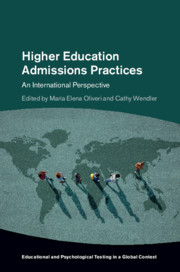Book contents
- Higher Education Admissions Practices
- Educational and Psychological Testing in a Global Context
- Higher Education Admissions Practices
- Copyright page
- Contents
- Figures
- Tables
- Contributors
- Series Editor’s Foreword
- Foreword
- Acknowledgments
- Part I Global Challenges and Common Admissions Models
- Part II Country-Specific Admissions Practices
- Chapter 7 Admissions Policies and Practices and the Reshaping of Access Patterns to Higher Education in Africa
- Chapter 8 Chile’s Admissions Tests: Pending Changes and Revisions
- Chapter 9 Issues of Perceived Fairness in Admissions Assessments in Small Countries: The Case of the Republic of Cyprus
- Chapter 10 Higher Education Admissions Practices in Israel
- Chapter 11 Access, Equity, and Admissions in South African Higher Education
- Chapter 12 Admissions Practices in Sweden
- Chapter 13 Revisions of Admissions Testing in Vietnam: From Elite to Mass Higher Education
- Part III Assessments Used in Higher Education Admissions
- Part IV Rethinking Higher Education Admissions
- Index
- References
Chapter 7 - Admissions Policies and Practices and the Reshaping of Access Patterns to Higher Education in Africa
from Part II - Country-Specific Admissions Practices
Published online by Cambridge University Press: 09 January 2020
- Higher Education Admissions Practices
- Educational and Psychological Testing in a Global Context
- Higher Education Admissions Practices
- Copyright page
- Contents
- Figures
- Tables
- Contributors
- Series Editor’s Foreword
- Foreword
- Acknowledgments
- Part I Global Challenges and Common Admissions Models
- Part II Country-Specific Admissions Practices
- Chapter 7 Admissions Policies and Practices and the Reshaping of Access Patterns to Higher Education in Africa
- Chapter 8 Chile’s Admissions Tests: Pending Changes and Revisions
- Chapter 9 Issues of Perceived Fairness in Admissions Assessments in Small Countries: The Case of the Republic of Cyprus
- Chapter 10 Higher Education Admissions Practices in Israel
- Chapter 11 Access, Equity, and Admissions in South African Higher Education
- Chapter 12 Admissions Practices in Sweden
- Chapter 13 Revisions of Admissions Testing in Vietnam: From Elite to Mass Higher Education
- Part III Assessments Used in Higher Education Admissions
- Part IV Rethinking Higher Education Admissions
- Index
- References
Summary
Higher education participation rates in Africa remain the lowest in the world, averaging around 7 percent of the eligible cohort. But the continent is also experiencing an increase in the number of youth, an increase in the demand for access to higher education, and a crisis of graduate unemployment. These issues have, in turn, resulted in a complex mix of policies that regulate admission and standards. This chapter discusses these issues and highlights the key prevailing trends in admissions and implications on access and equity in higher education admissions in Africa.
- Type
- Chapter
- Information
- Higher Education Admissions PracticesAn International Perspective, pp. 123 - 144Publisher: Cambridge University PressPrint publication year: 2020



